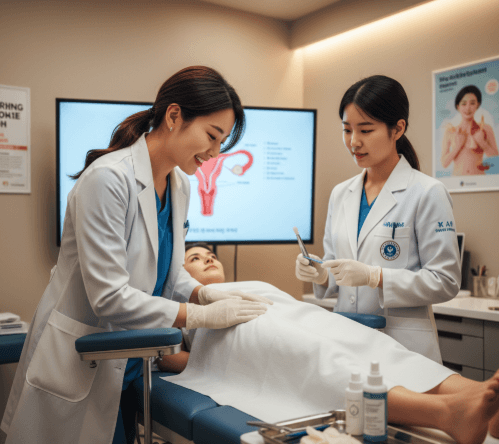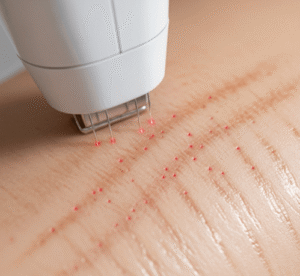What it is
A routine pelvic exam is a medical check-up performed by a gynecologist to assess the health of the female reproductive organs. It involves the inspection of the vulva, vagina, cervix, uterus, fallopian tubes, and ovaries.
✔️ Purpose: To detect early signs of disease, infections, or abnormalities.
✔️ Duration: Usually takes about 10–15 minutes.
The exam may include:
➡️ Visual inspection of the external genitalia
➡️ Speculum examination to view the cervix and vaginal walls
➡️ Bimanual exam where the doctor checks uterus and ovaries by feeling with hands
➡️ Sometimes, a Pap smear or HPV test is also performed during the same session
Why it’s done
Routine pelvic exams are essential for preventive healthcare. Doctors recommend them because they:
🔹 Detect early cervical or ovarian cancer signs
🔹 Identify sexually transmitted infections (STIs)
🔹 Help diagnose pelvic inflammatory disease
🔹 Monitor menstrual irregularities, pelvic pain, or abnormal bleeding
🔹 Provide reassurance for women’s reproductive health
💡 Highlight: Even if you feel healthy, pelvic exams help in early disease detection before symptoms appear.
Alternatives
While a pelvic exam is standard, there are alternative or complementary options:
➡️ Pap smear or HPV testing alone – can detect cervical abnormalities without a full pelvic exam
➡️ Ultrasound imaging – evaluates uterus and ovaries without physical examination
➡️ Self-reported symptom check + lab tests – for infections or hormonal issues
➡️ STI urine/blood tests – may replace part of the exam if infections are suspected
⚠️ However, these methods may not completely replace a pelvic exam, as physical examination provides unique insights.
Preparation
Preparing for a pelvic exam in Korea is simple but important:
✔️ Schedule mid-cycle (not during menstruation) for best results
✔️ Avoid sexual intercourse, vaginal medications, or douching 24 hours before the exam
✔️ Prepare a list of symptoms or questions for the doctor
✔️ Bring medical history including contraception use, previous conditions, or past surgeries
✔️ Wear comfortable clothing for ease during examination
💡 Tip: Mental preparation is important. Pelvic exams may feel uncomfortable, but in Korea, doctors ensure privacy, gentle communication, and professionalism.
How it’s done
A routine pelvic exam in Korea follows these steps:
- Medical history discussion → Doctor asks about symptoms, menstrual cycle, and sexual health
- Positioning → Patient lies on the exam table with feet supported in stirrups
- Visual inspection → Doctor checks the vulva for irritation, sores, or swelling
- Speculum exam → A sterile speculum is gently inserted to open the vaginal canal
- Cervix is examined
- Pap smear or HPV sample may be collected
- Bimanual exam → Doctor uses one hand inside the vagina and the other on the abdomen to feel uterus and ovaries
- Optional rectovaginal exam → Sometimes performed to check deeper pelvic organs
⏩ The entire procedure usually takes less than 15 minutes and is not painful, though some pressure may be felt.
Recovery
Recovery from a pelvic exam is immediate:
✔️ You can resume daily activities right away
✔️ Mild spotting after Pap smear is normal
✔️ No rest or downtime is required
✔️ Results from Pap smear or lab tests are usually available in a few days
💡 When to call doctor after exam?
➡️ Heavy bleeding
➡️ Severe abdominal pain
➡️ Unusual discharge with odor
Treatment option in Korea
Korea is well-known for its advanced women’s healthcare system. For routine pelvic exams:
⭐ Gynecology clinics and university hospitals provide affordable and professional care
⭐ Examinations are conducted by highly trained Korean gynecologists
⭐ Language assistance services are available in major hospitals for foreigners
⭐ Many hospitals offer combined health check-up packages that include pelvic exams, Pap smears, breast exams, and blood work in one visit
⭐ Privacy and comfort are prioritized – Korean clinics are modern, clean, and patient-focused
💡 Highlight: Choosing a pelvic exam in Korea ensures accurate diagnostics, modern equipment, and caring doctors who respect patient comfort.
Key Highlights
✔️ Prevents serious diseases by early detection
✔️ Quick & simple procedure – takes about 10–15 minutes
✔️ Minimal discomfort with professional care
✔️ Optional alternatives exist but may not fully replace a pelvic exam
✔️ Korean healthcare system offers advanced facilities and multilingual support













